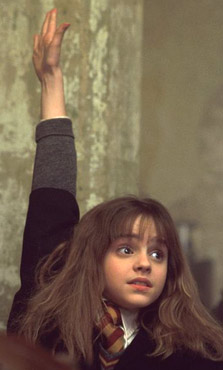
“Harry Potter” is one of those enchanting films that delights from start to finish because its story never panders to the kids in its audience, and refrains from throwing in a lot of wink-wink jokes for the adults, an annoying habit of recent “children’s” films. Innocent without mawkishness, it’s simply a movie about kids, not a kid’s movie. That’s probably because the backbone of the story is essentially a tale of English schoolboys, so right away we’re spared the undignified ravings of American brats. Cuteness isn’t high on its list of priorities, and so, naturally, thanks in large part to perfect casting, the film is about as cute as any you’re likely to see.
Daniel Radcliffe as Harry was the best casting job of all, since the likeability of the main character in a film like this is often the difference between a truly special movie and a pointless special effects show. Peering out at his brave new world through glasses that would seem comically exaggerated in any other context, Radcliffe gives Harry exactly the sort of thoughtful integrity he should possess. The effect of the round spectacles gives him a look of permanent wide-eyed wonder, a low-tech magnification of his expressive eyes. What’s endearing about Harry is the fact that his rather cruel Dickensian origins have not defeated him to the slightest degree. There isn’t a trace of self-pity in Harry at all, which is nice, since they could have played up the sympathy angle more than they did. On the train to Hogwarts, for instance, his friend Ron reluctantly pulls a homemade snack from his pocket instead of purchasing some candy, but it’s Harry who feels compassion for his new friend and buys sweets for them both. Later, Harry’s meeting with his parents avoids the saccharine weepiness that would have sunk many a lesser movie. There’s a lot of heart in “Harry Potter”, but very little sentimentality.
Normally, fantasy films seem as if the effects have been added as secondary considerations to serve a human, ‘real’ story—just like the screenwriting gurus teach their pupils—but now and then a movie can get away with putting a human, ‘real’ story in the service of a wonderfully artificial world. More is less: the special effects are so sweeping and all-inclusive that they recede into the background rather than announce their comings and goings; something like “The Matrix”, as good as its effects are, slows to a stop—literally, in those overrated “bullet time” scenes—almost every time those effects appear. Going so far in the other direction has brought us back to the simplest elements of our human stories, but only masterpieces of technical artistry can achieve that.
“Harry Potter” is one of those. The special effects should win every award the industry has. They exist not to distract us from a story wanting in logic, which is so often the case, but are actually central to the story. From floating candles to flying keys, from baby dragons to magic brooms, the filmmakers have had so much fun creating their magical props and sets you can’t help feeling bursts of joy just for the quality of craftsmanship. “Harry Potter” has, in this new age of boundless computer effects, only one peer for visual artistry, and that’s “Star Wars Episode One”. Both films, alone among the dozens of cartoonish monstrosities that have come along since CG effects came of age, succeed in creating an entirely new and inhabitable world in which to place their characters, primarily because of fastidious attention to detail (watch the paintings on the walls in Hogwart’s). The special effects crew are more than technicians who assist the director, they become artists themselves, and their stamp is as prominent as the writer’s, director’s, or actors’.
Another thing “Harry Potter” has in common with “The Phantom Menace”, sadly, is that the story isn’t quite up to the level of its extraordinary visuals. Although I’ve not read the “Harry Potter” books, having seen the film I can now say that the cult surrounding the Harry Potter series surprises me because of the yarn’s remarkable paucity of imagination. I don’t mind the recycling of mythology so much, since many fine films, namely my beloved “Star Wars” (another tale of wizards and quests), reuse various legends and myths. No, it’s the magic I’m talking about. The magic-casting and use of enchanted items is always fun and often amusing, but lacks the distinguishing cleverness one would expect from such a beloved franchise: most of the film’s magic could have been inspired by walking down the toy aisle at K-Mart. Quidditch is a mishmash of rugby and basketball, while one of Harry’s adventures involves an enchanted chess set. A Christmas gift is a cloak that makes its wearer invisible, and the head wizard, Dumbledore, can summon dinner with Latin. Adequate enough, but adequate is rather underwhelming given the bravura artistry on display: think Michelangelo sculpting nifty flower pots.
As for the movie’s plot, nearly all of Harry’s advances are too easy. When he needs to know something, someone tells him. When he needs to have something, someone gives it to him. The filmmakers were keen to make it up to Harry for his deprived childhood. Nevertheless, these complaints are somewhat churlish considering the film’s many other charms. After all, when you’re reaching for favorable “Star Wars” comparisons in a movie review, that’s recommendation enough. |